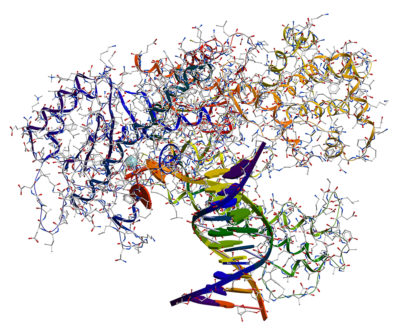
A research team led by Michael Blaber of Florida State University College of Medicine recently reported a solution to a problem with the “protein-first,” also known as the protein self-assembly origin of life theory. The issue involves protein folding. Biologically active proteins are only functional when folded into specific molecular structures.
Blaber presented evidence demonstrating the folding of proteins through a self-assembly origin of life process. The fold-ability of proteins into specific structures is essential to perform cellular functions. While the team’s approach aligns with Charles Darwin’s theory, protein self-assembly origin of life is competing with the more popular “RNA-first” origin of life theory.
Darwin ascribed to the “protein-first” theory. In a letter to his closest friend, Joseph D. Hooker, in 1871, speculating on how the origin of life might have happened, Darwin wrote –
“The first production of a living organism [stemmed from]… in a warm little pond with all sorts of ammonia & phosphoric salts, −light, heat, electricity, &c present, that a protein compound was chemically formed, ready to undergo more complex changes”
Study Findings
Published in the January 2013 issue of the Proceedings of the National Academy of Sciences, Blaber’s (pictured right) paper was entitled, “Simplified protein design biased for prebiotic amino acids yields a foldable, 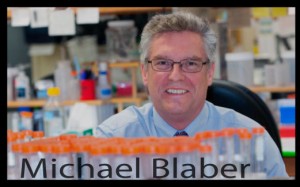 halophilic protein.” The findings were the product of a three-year investigation.
halophilic protein.” The findings were the product of a three-year investigation.
The team used halophiles in a specialized technique developed over more than 17 years. Halophiles are microorganisms living in high-salt concentration environments.
In an April 14, 2013 interview with Doug Carlson of PhosOrg, “The current paradigm on the emergence of life is that RNA came first and in a high-temperature environment,” Blaber noted. However,
“The data we are generating are much more in favor of a protein-first view in a halophile environment.”
The halophile environment in the study used temperatures over 30 degrees centigrade (over 86 degrees Fahrenheit) and very high concentrations of salt concentrations – 5-times greater than ocean salinity.
The halophile environment shifts the paradigm in the “protein-first” origin of life theory. “The halophile, or salt-loving, the environment has typically been considered one that life adapted into, not started in,” Blaber explained in the interview –
“Our study of the prebiotic amino acids and protein design and folding suggests the opposite.”
Blaber demonstrated that foldable proteins could naturally develop in this specific halophilic environment – a big step. In the “protein-first” model, the folding of amino acid chains into a protein-specific structure is critical for the molecule to be biologically active.
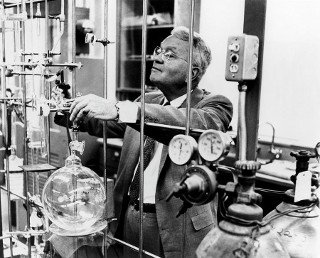 Blaber is the first to demonstrate the production of foldable amino acid chains in the famous oxygen-free “cosmochemistry” environment. Nobel Prize winner Harold Urey (pictured left) 1952 initially proposed this theory.
Blaber is the first to demonstrate the production of foldable amino acid chains in the famous oxygen-free “cosmochemistry” environment. Nobel Prize winner Harold Urey (pictured left) 1952 initially proposed this theory.
In 1953, the Miller-Urey experiment demonstrated the production of amino acids but without any proteins formed. Blaber, however, successfully demonstrated the production of foldable proteins from 12 amino acids using a technique called “top-down symmetric deconstruction.”
“Rather than a curious niche that life evolved into, the halophile environment,” Blaber argued, “now may take center stage as the likely location for key aspects of abiogenesis.” Continuing, Blaber noted –
“Likewise, the role of the formation of proteins takes on additional importance in the earliest steps in the beginnings of life on Earth.”
Early Earth Atmosphere Challenge
Before Darwin’s “protein-first” hypothesis regains mainstream traction, though, issues with early Earth’s atmosphere must be solved. The early Earth was oxygen-poor conditions resulting in a reducing atmosphere filled with noxious methane, carbon monoxide, hydrogen sulfide, and ammonia.
Just a year after Urey advocated the “cosmochemistry,” University of Chicago geochemist Harrison Brown was one of the first to suggest that either the Earth must have lost its original interstellar atmosphere or it never had a reducing atmosphere without oxygen.
Princeton University geochemist Heinrich Holland, in 1960s, and Carnegie Institution geophysicist Philip Abelson, agreed with Harrison Brown’s observation. Working independently, Holland and Abelson concluded that the Earth’s primitive atmosphere was not an oxygen-free environment.
In 1975, Belgium biochemist Marcel Florkin denounced the reducing atmosphere theory, stating, “the concept of a reducing primitive atmosphere has been abandoned,” and the Miller–Urey experiment is “not now considered geologically adequate.”
In 1982, British geologists Harry Clemmey and Nick Badham wrote in the journal of Geology that the evidence showed that “from the time of the earliest dated rocks at 3.7 billion years [sic], Earth had an oxygenic atmosphere.”
As Jonathan Cohen (pictured right) wrote in the journal Science in 1995, many origin-of-life researchers now dismiss the 1953 experiment because “the early atmosphere looked nothing like the Miller–Urey 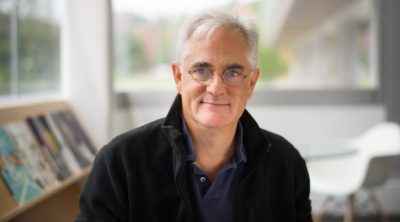 simulation.”
simulation.”
Dustin Trail of the Department of Earth and Environmental Sciences at Rensselaer Polytechnic Institute in New York reported a significant finding in the prestigious journal Nature in 2011. Found in molten rock (magmas) estimated to be 4,000 million years old [sic] was evidence for oxygen. The paper entitled “The oxidation state of Hadean magmas and implications for early Earth’s atmosphere,” co-authored by E. Bruce Watson and Nicholas D. Tailby, reported –
“We find that the melts have average oxygen fugacities [gas pressure] that are consistent with an oxidation state… similar to present-day conditions.”
Oxygen on early Earth was similar to today−not, a reducing atmosphere as Urey’s “cosmochemistry” theory had required and used by Blaber.
In an interview posted on The Daily Galaxy, Watson put into perspective the implications of the finding –
“We can now say with some certainty that many scientists studying the origins of life on Earth simply picked the wrong atmosphere.”
Raw Chemical Resources
The atmosphere is not alone in straining Blaber’s theory, and so is the unavailability of raw chemical resources for the formation of amino acids. According to Dean Kenyon, a biology professor at San Francisco State University, there have never been enough resources on Earth to form even one protein molecule –
“If the association of amino acids were a completely random event… there would not be enough mass in the entire Earth, assuming it was composed exclusively of amino acids, to make even one molecule of every possible sequence of… a low-molecular-weight protein.”
Self-Assembly Limits
Even if there were enough resources, the concept of self-assembling is a problem. As an inherently redundant theory, the self-assembly origin of life theory undermines the development of complexity and diversity. 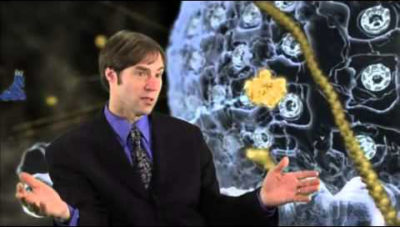 As Stephen C. Meyer (pictured left) in the book Signature in the Cell explains,
As Stephen C. Meyer (pictured left) in the book Signature in the Cell explains,
“Therefore, self-organizational forces of chemical necessity [self-assembly], which produce redundant order and preclude complexity, preclude the generation of specified complexity.”
In the book Life Itself, Nobel Prize winner and co-discoverer of the DNA molecule Francis Crick explains,
“An honest man, armed with all the knowledge available to us now, could only state that in some sense, the origin of life appears at the moment to be almost a miracle, so many are the conditions which have to be satisfied to get it going.”
Refer to the Glossary for the definition of terms and to Understanding Evolution to gain insights into understanding evolution.
2020 Updates
“Protein-First”
While the RNA world model may be the most popular, the “protein-first” self-assembly origin of life model still has advocates. Jordana Cepelewicz, staff writer for Quanta Magazine (2017) in the article “Life’s First Molecule Was Protein, Not RNA, New Model Suggests.” As the subtitle explains –
“Which mattered first at the dawn of life: proteins or nucleic acids? Proteins may have had the edge of a theorized process let them grow long enough to become self-replicating catalysts.”
Astrobiology at NASA
On April 13, 2020, NASA updated the Research Highlight “Earth’s Early Atmosphere” memorandum posted in December 2011. The update, entitled Earth’s Early Atmosphere: An Update, states –
“The findings, which appear in the current issue of Nature, are the first direct evidence of what the ancient atmosphere of the planet was like soon after its formation and directly challenge years of research on the type of atmosphere out of which life arose on the planet…
“Now, scientists at Rensselaer are turning these atmospheric assumptions on their heads with findings that prove the conditions on early Earth were simply not conducive to the formation of this type of atmosphere but rather to an atmosphere dominated by the more oxygen-rich compounds found within our current atmosphere — including water, carbon dioxide, and sulfur dioxide.”
Since the evolution industry subscribes to the theory of everything, any possibility is possible even though highly improbable.
Genesis
The origin of life problems intensifies the Darwin Dilemma. As WIKIPEDIA explains, “The origin of life on Earth is a scientific problem which is not yet solved. There are many ideas, but few clear facts.”
The Genesis account continues to stand as a predictor of valid scientific theories. Max Planck (pictured right), a German theoretical physicist, proposed the theory of quantum mechanics awarded the Nobel Prize in Physics in 1918 –
“Yet in the whole of the universe there is no force that is either intelligent or eternal, and we must therefore assume that behind this force there is a conscious, intelligent Mind or Spirit. This is the very origin of all matter.”
Refer to the Glossary for the definition of terms.

